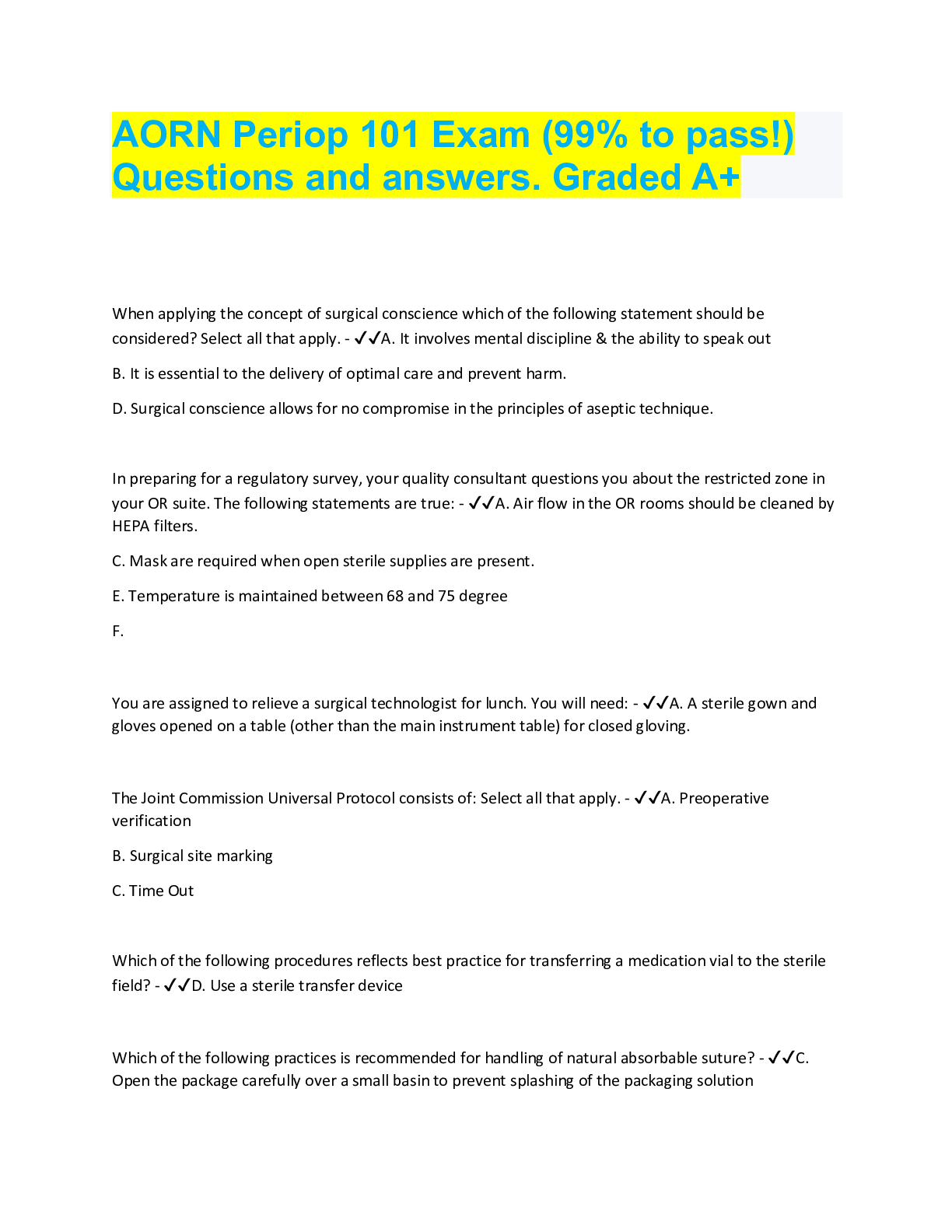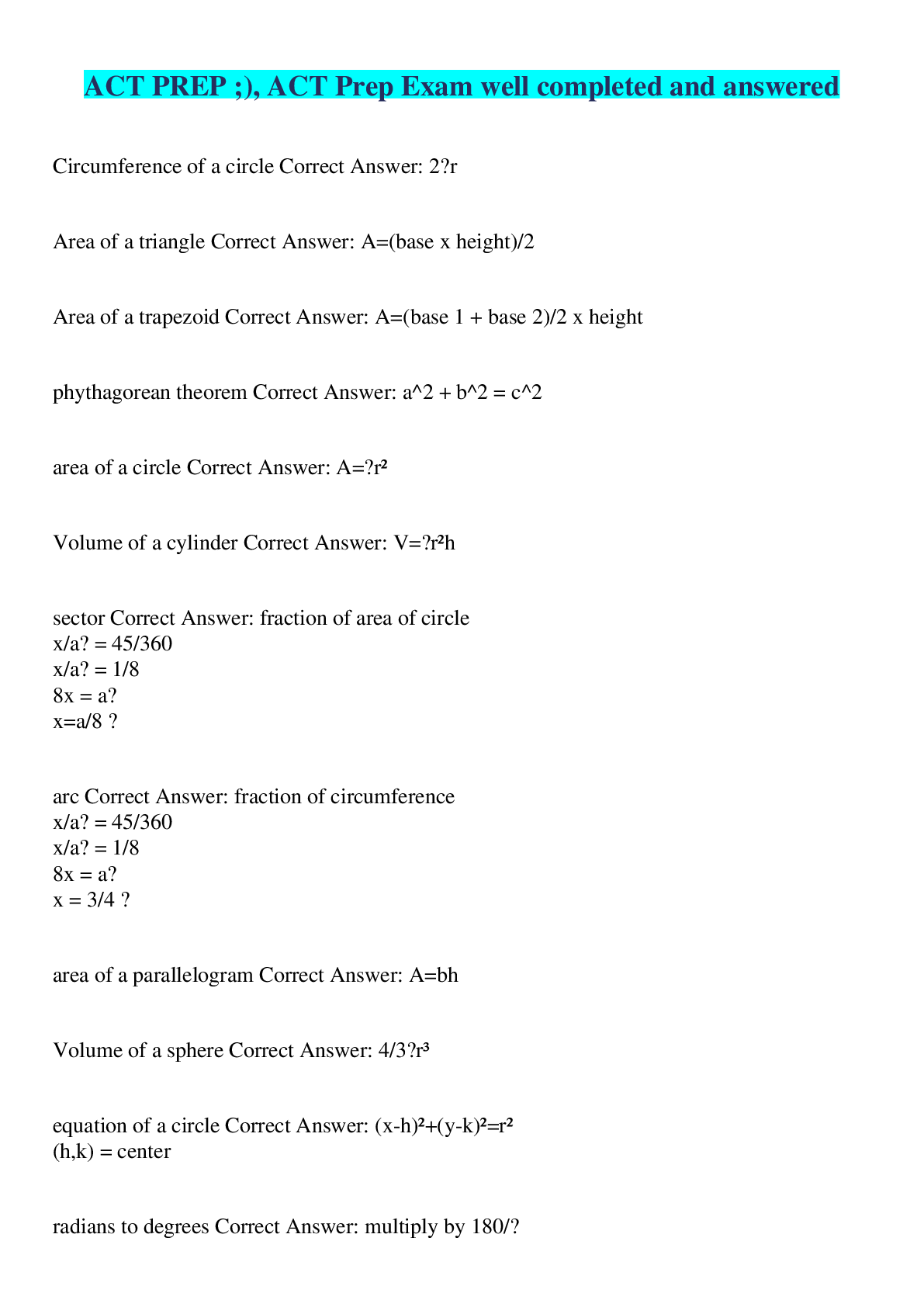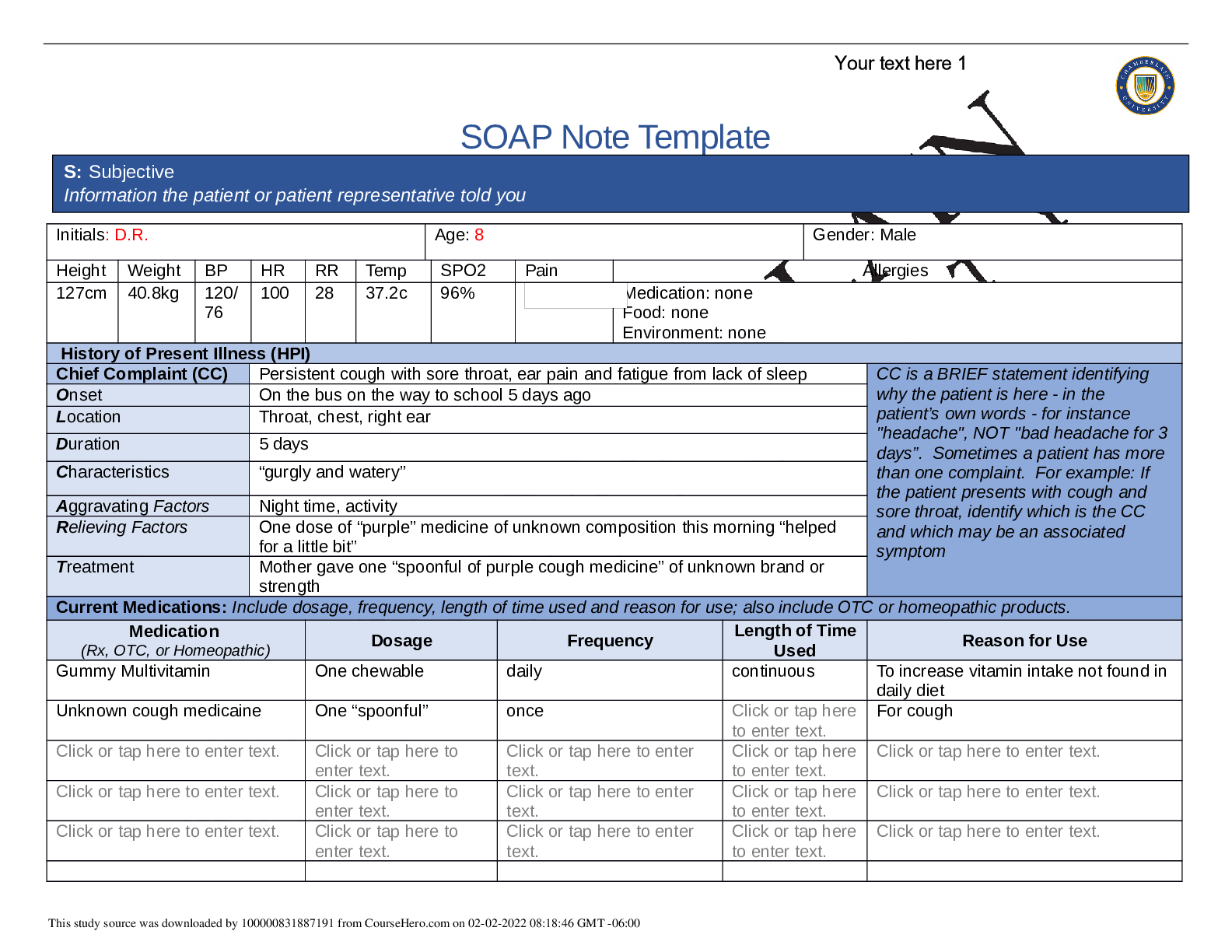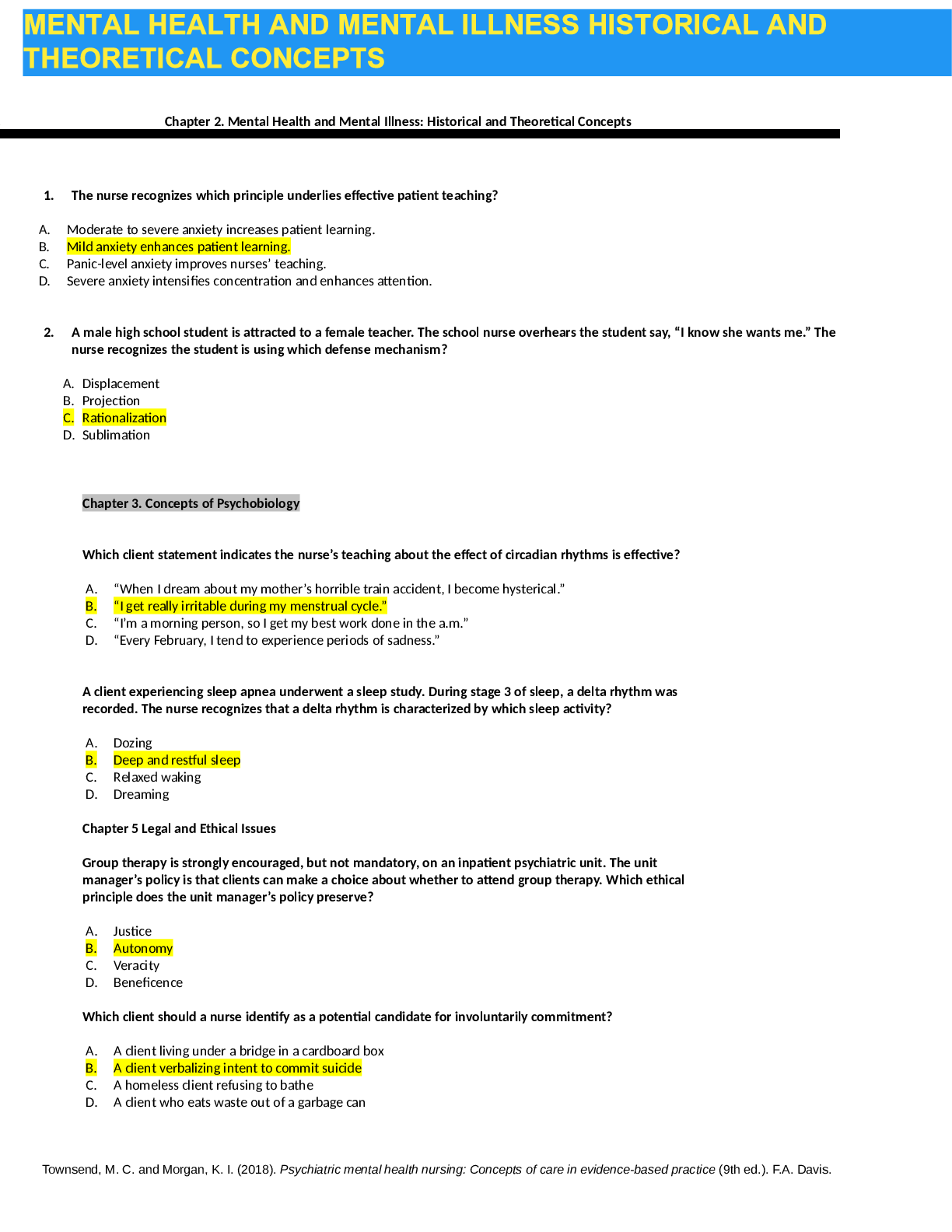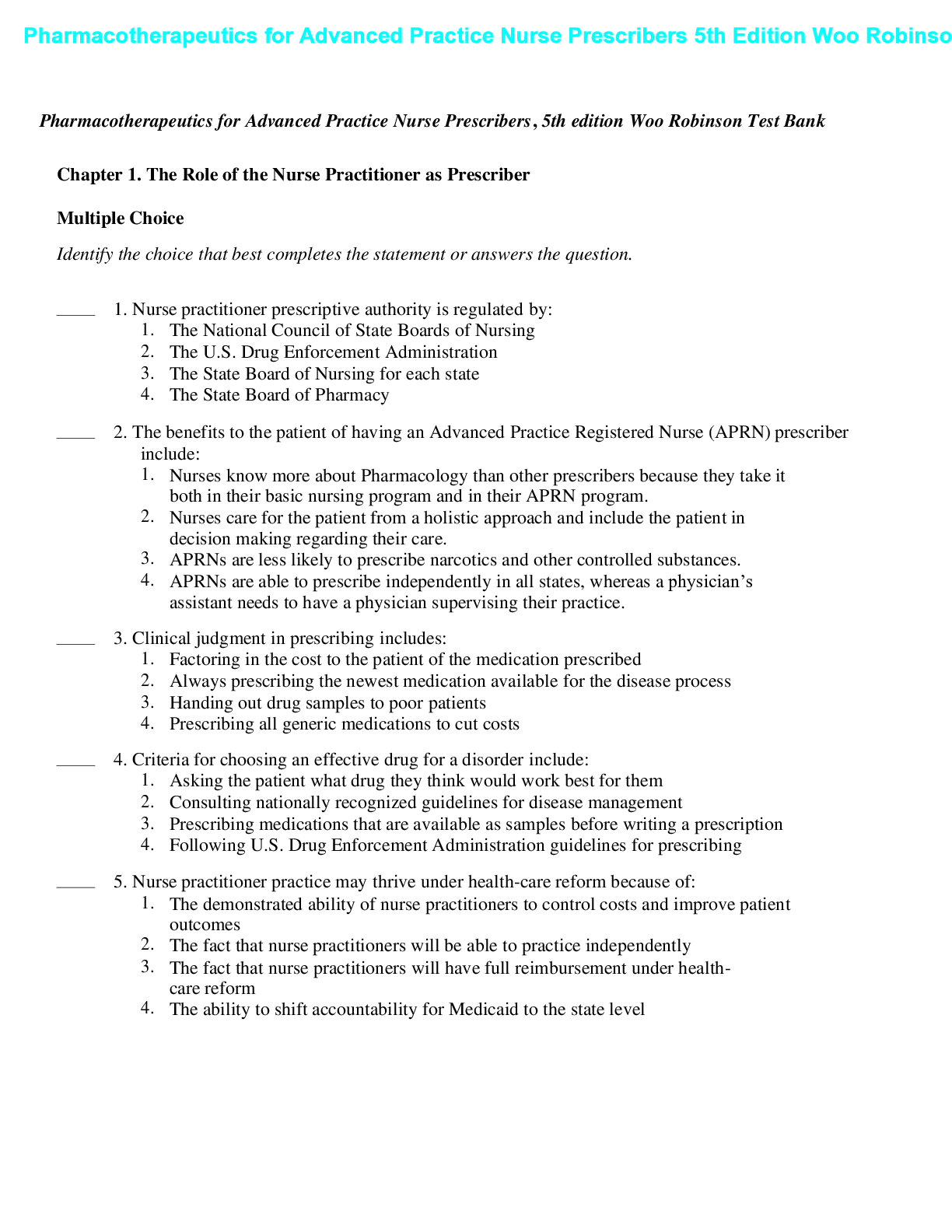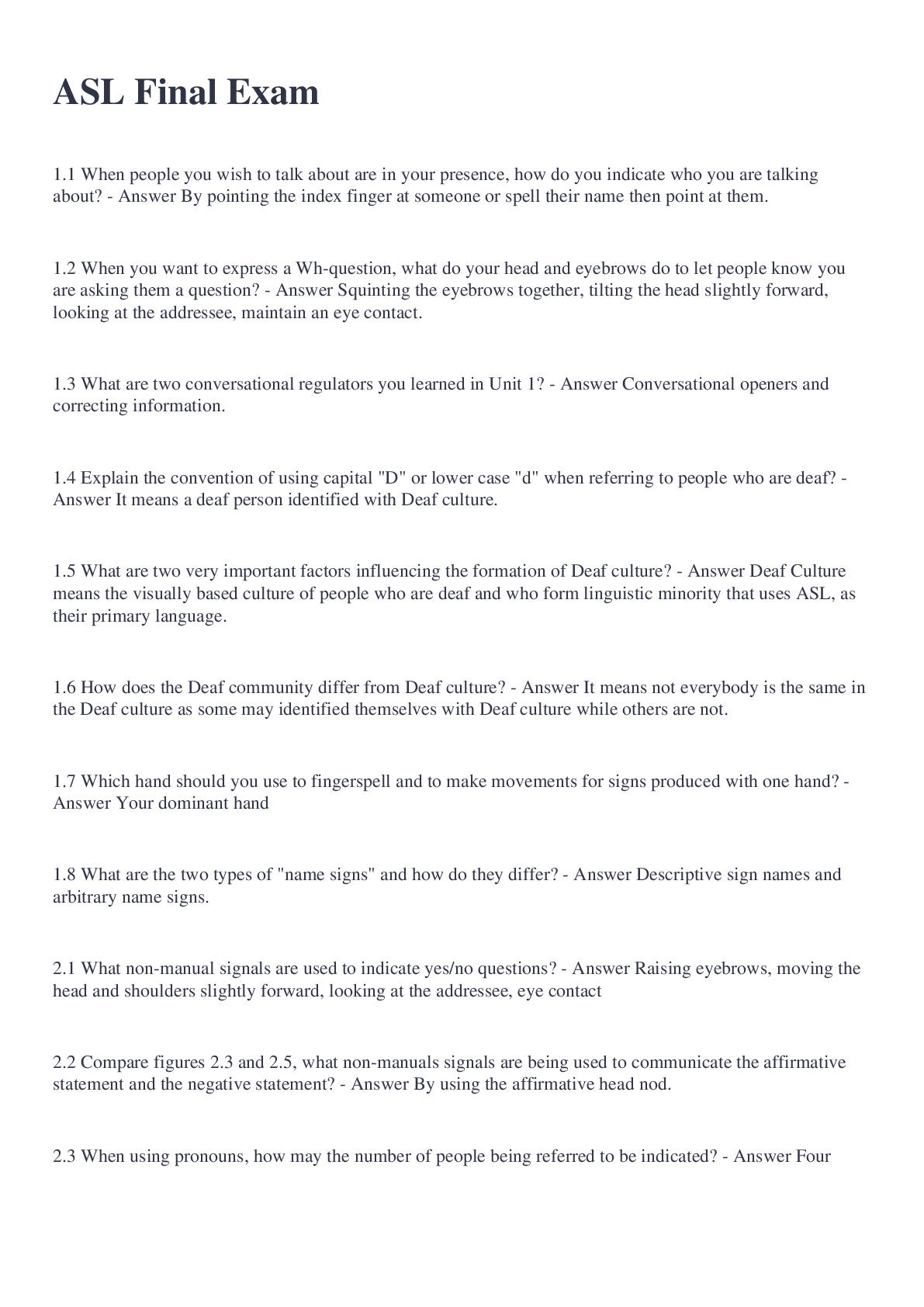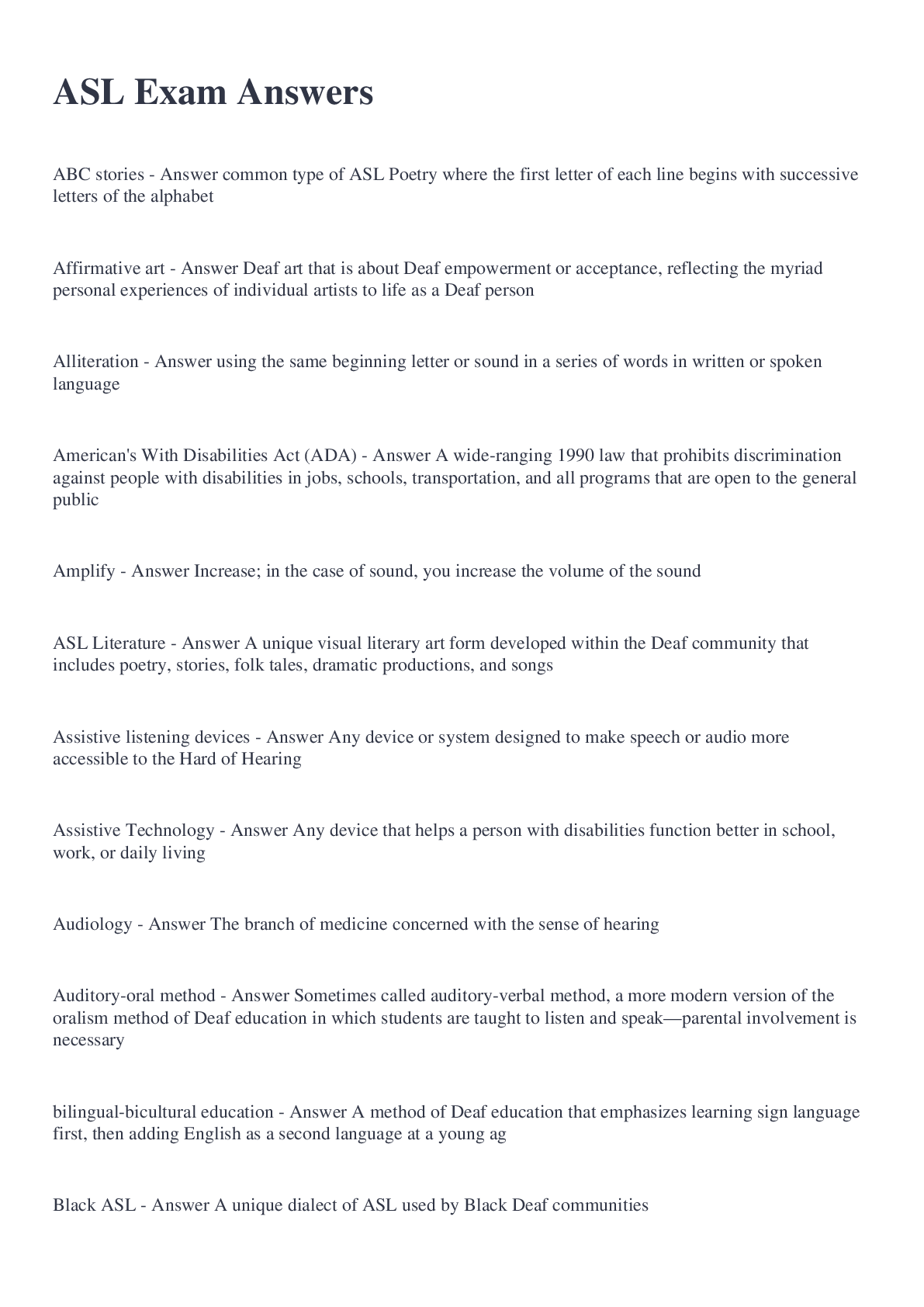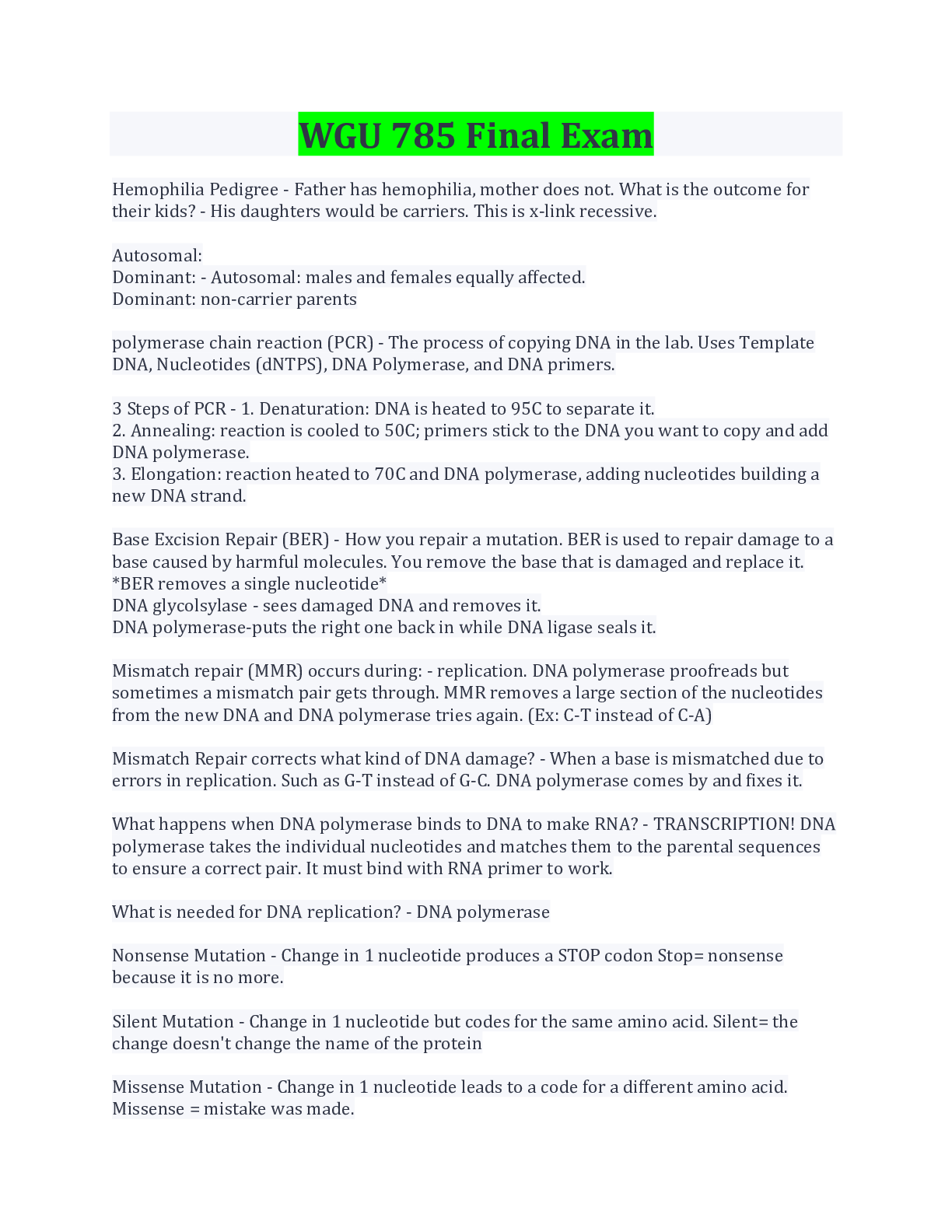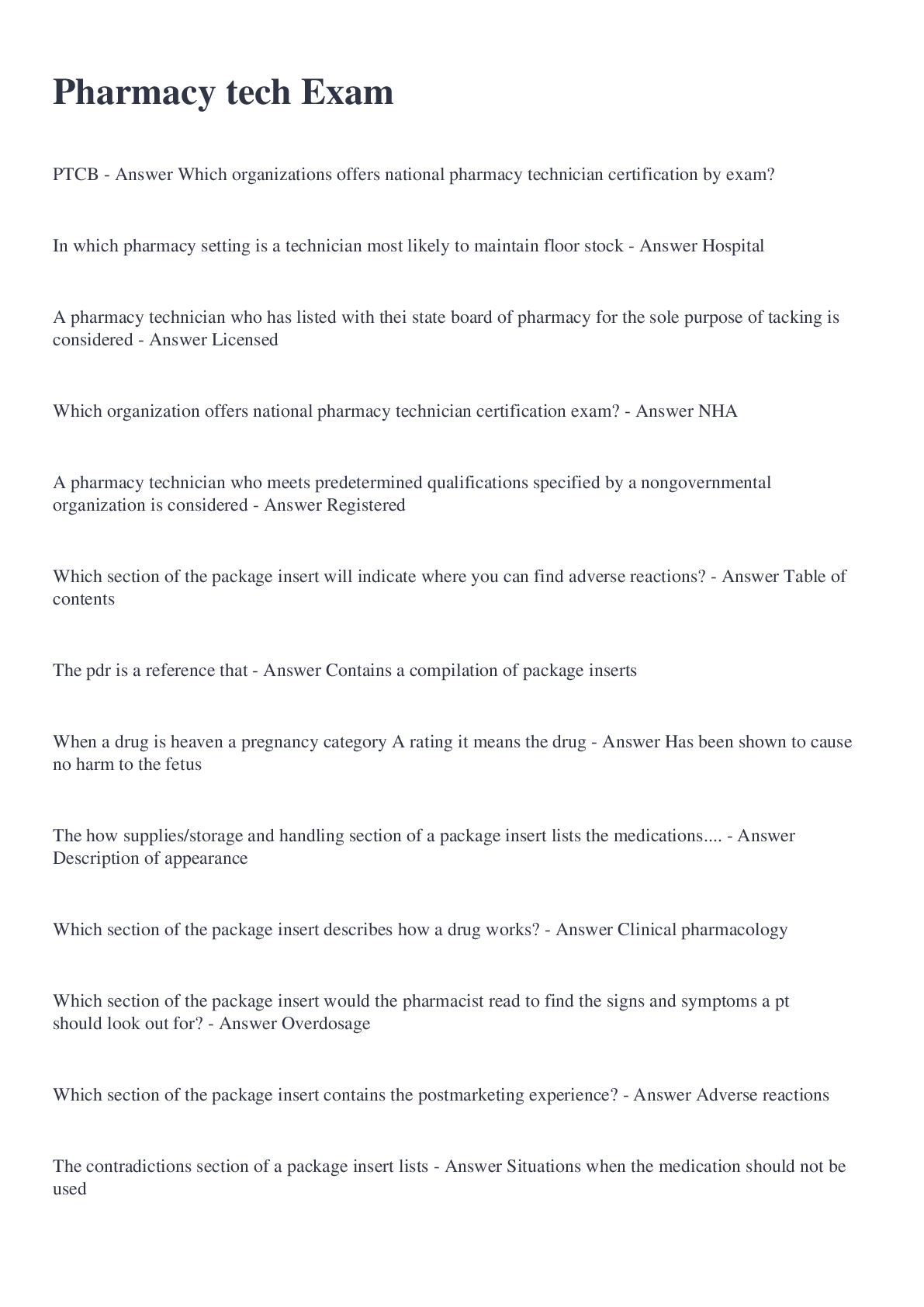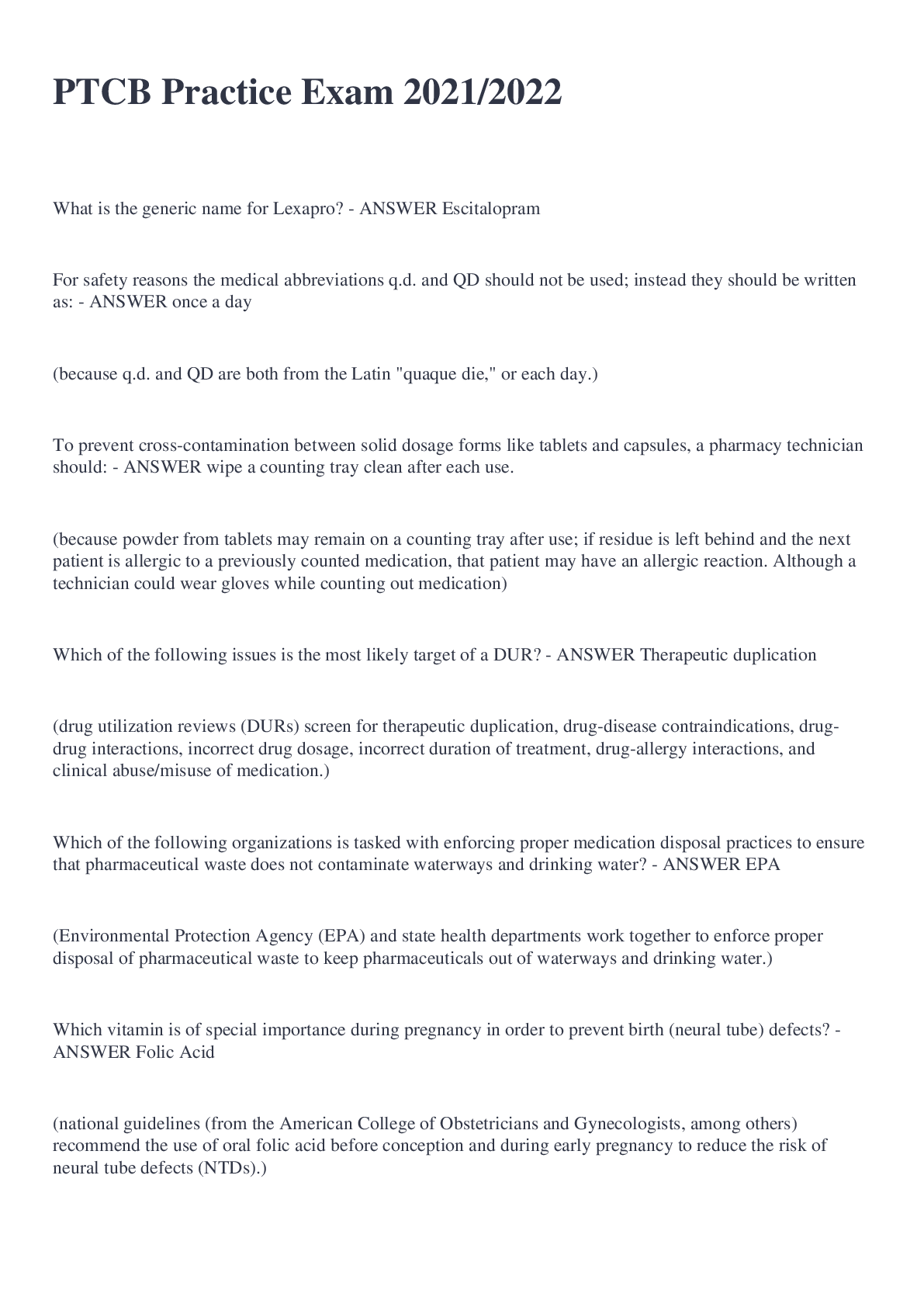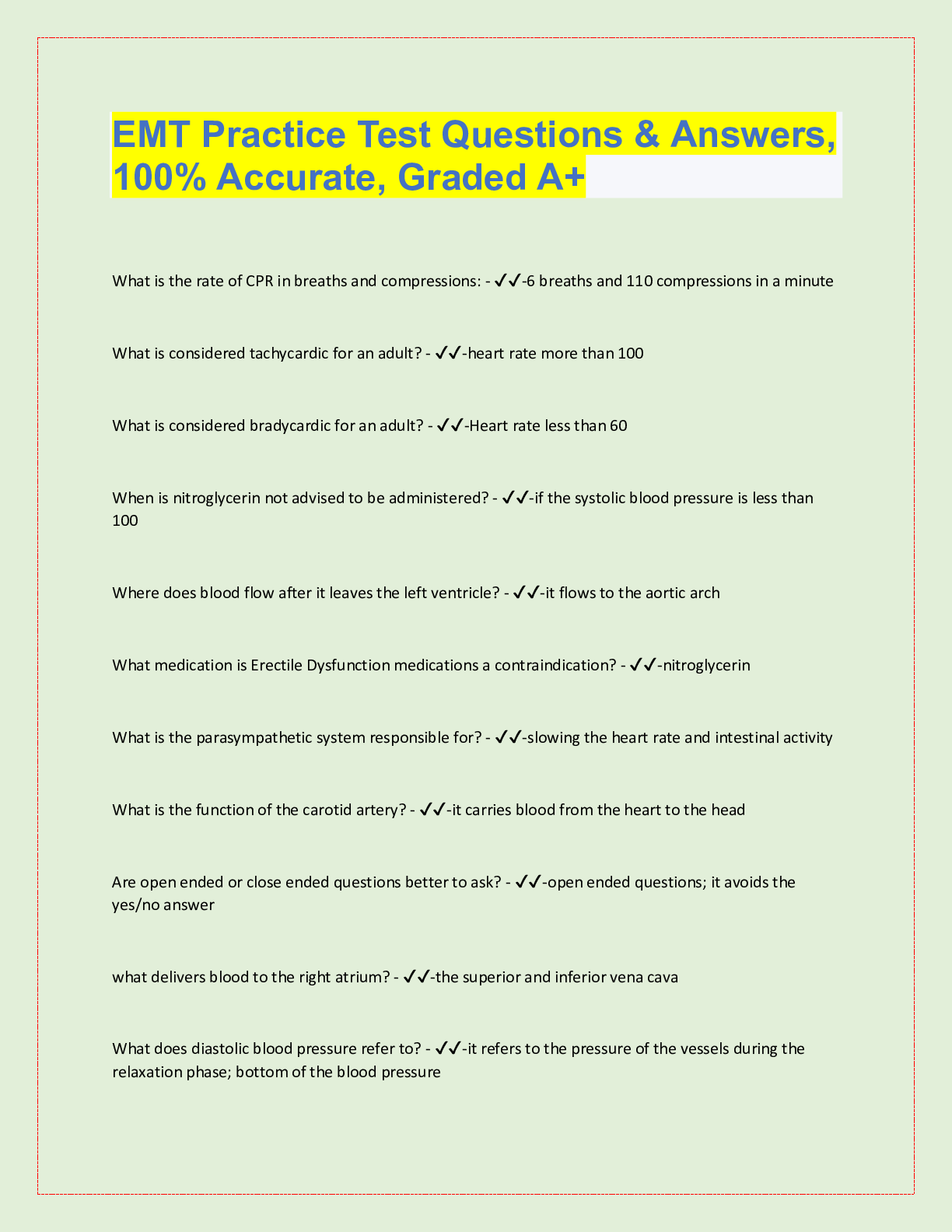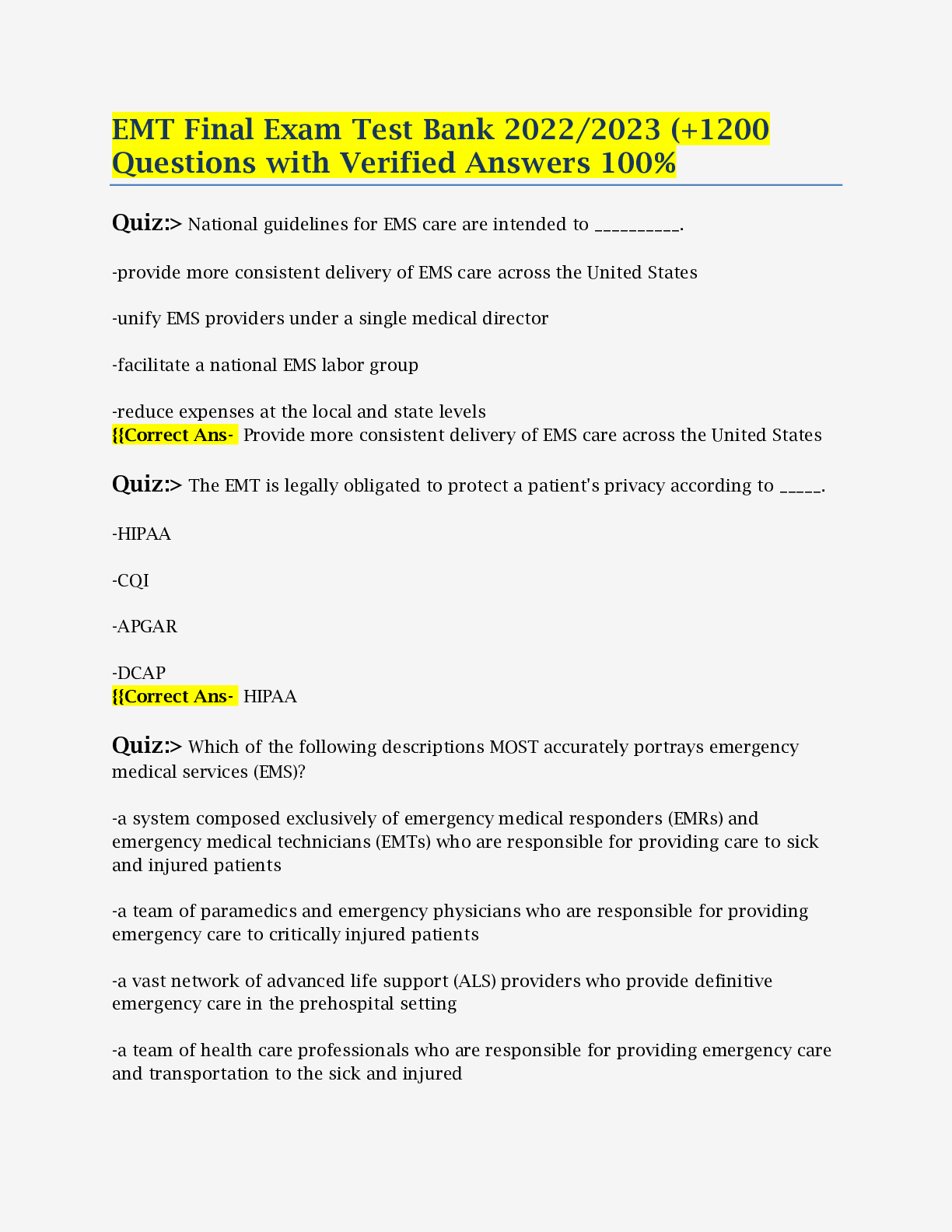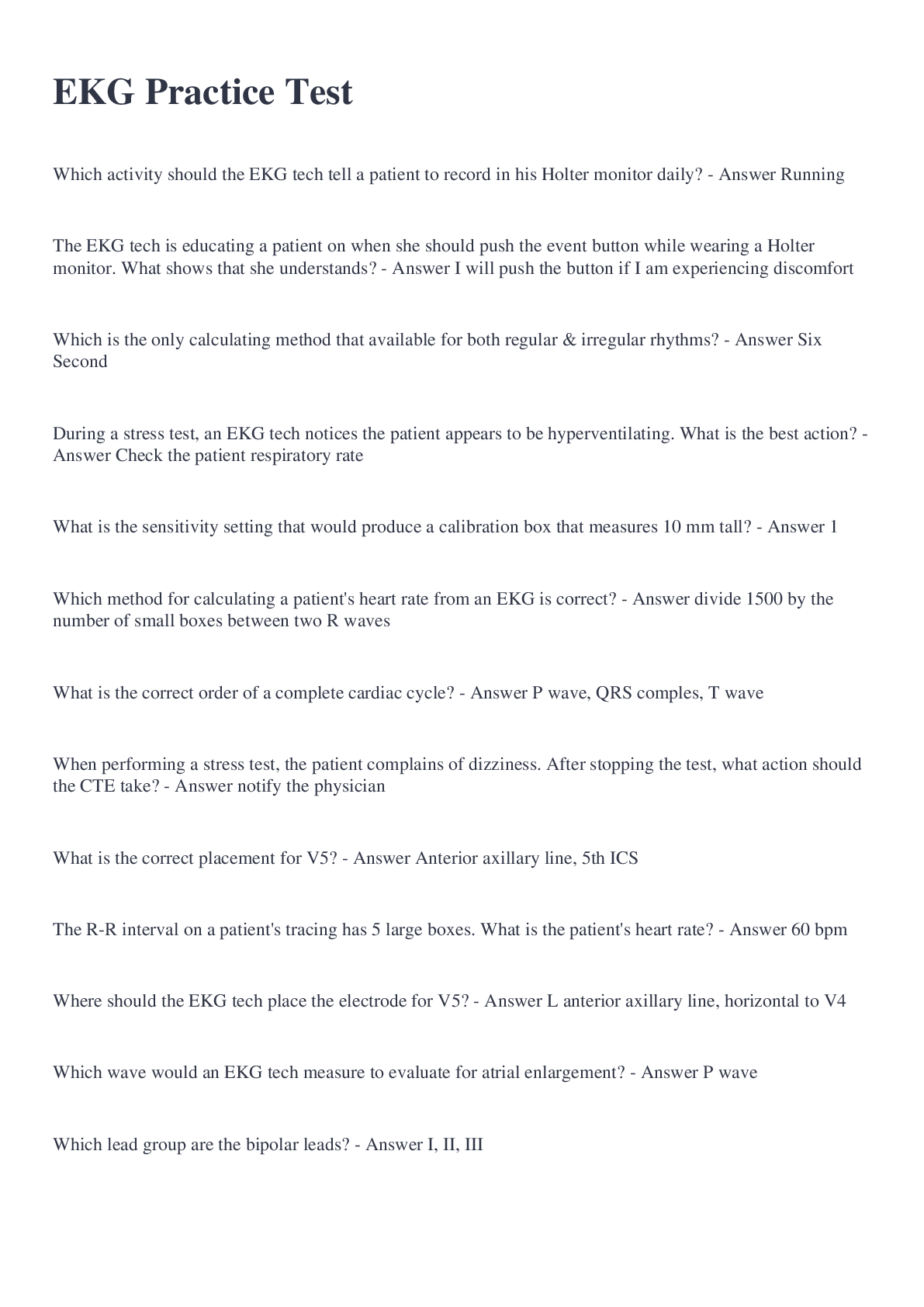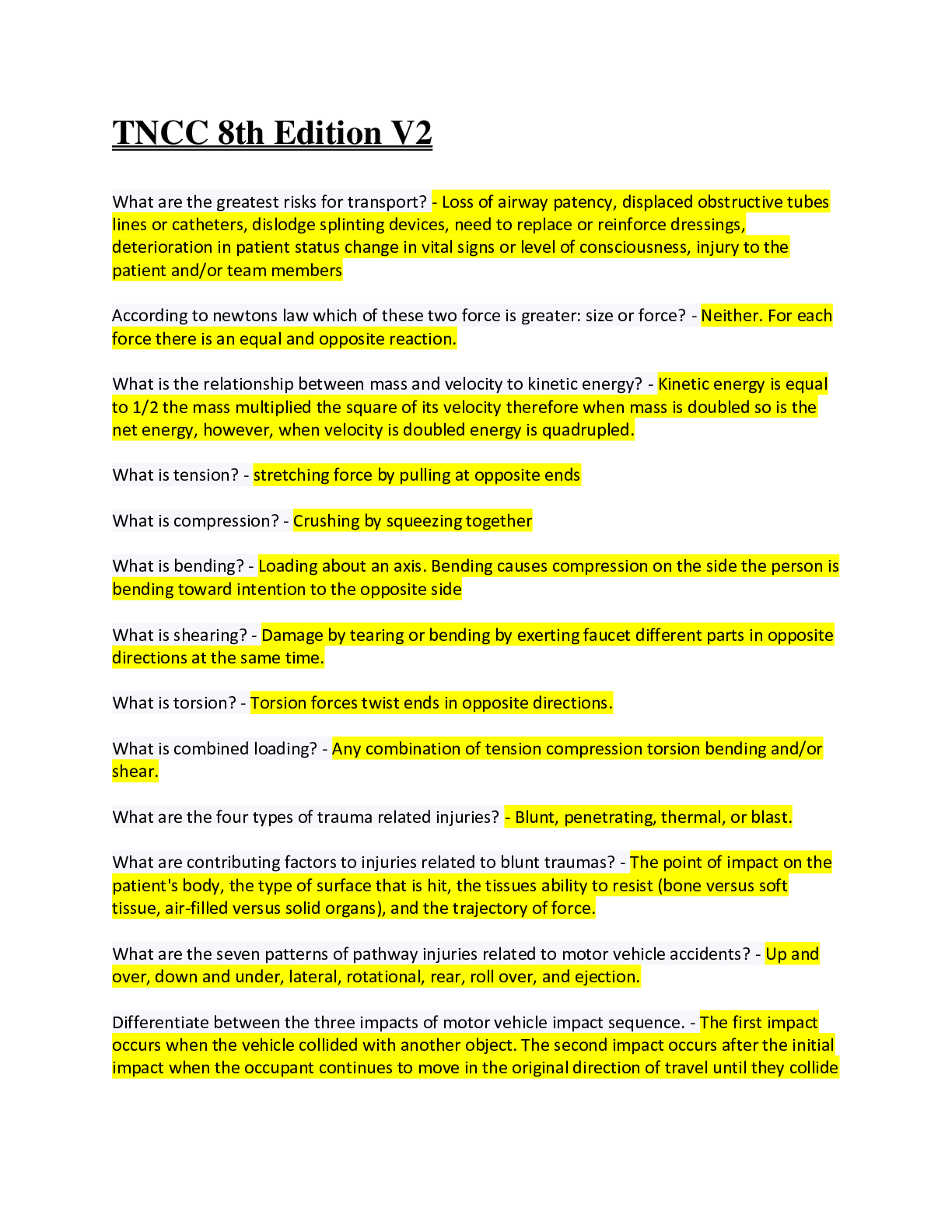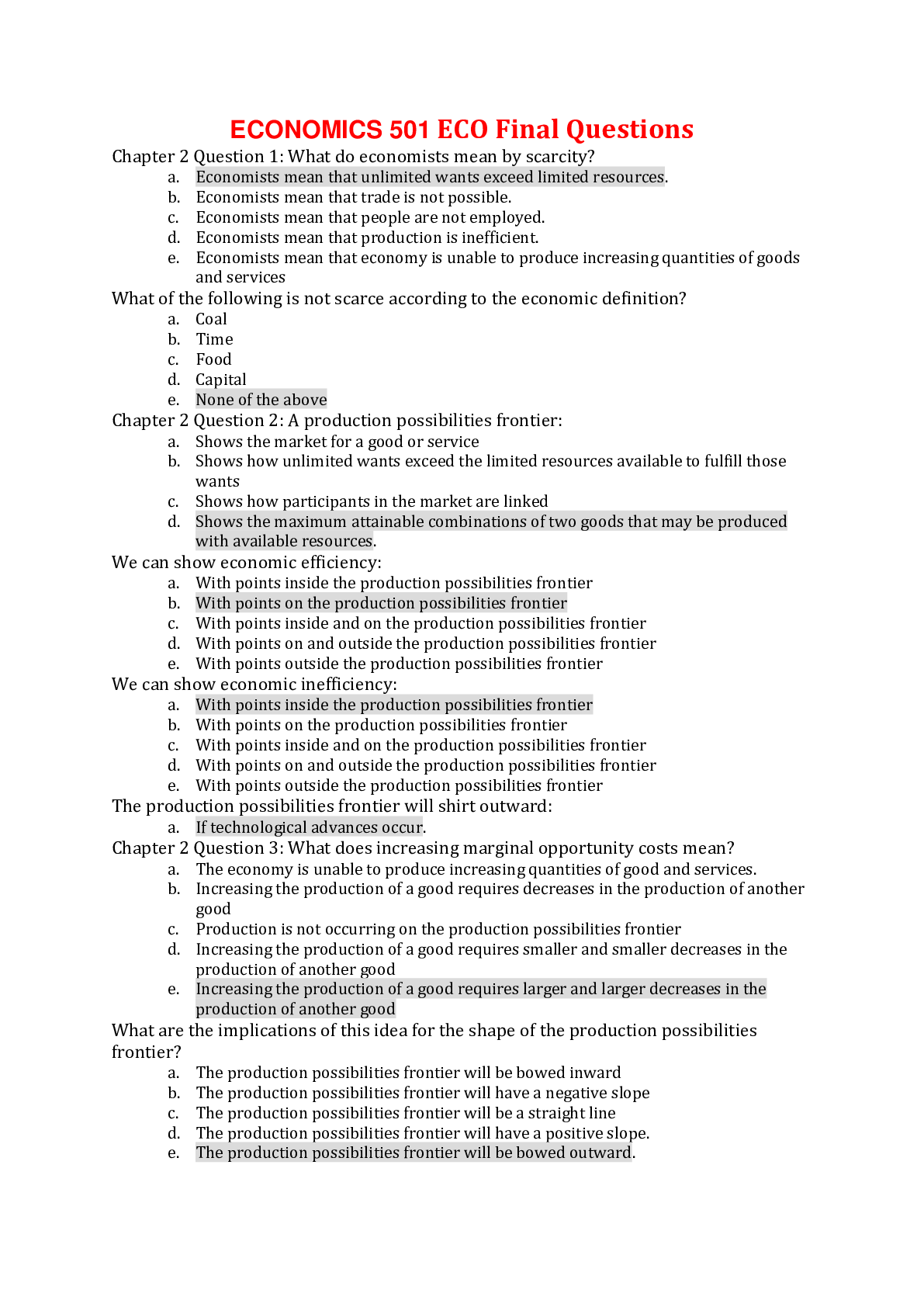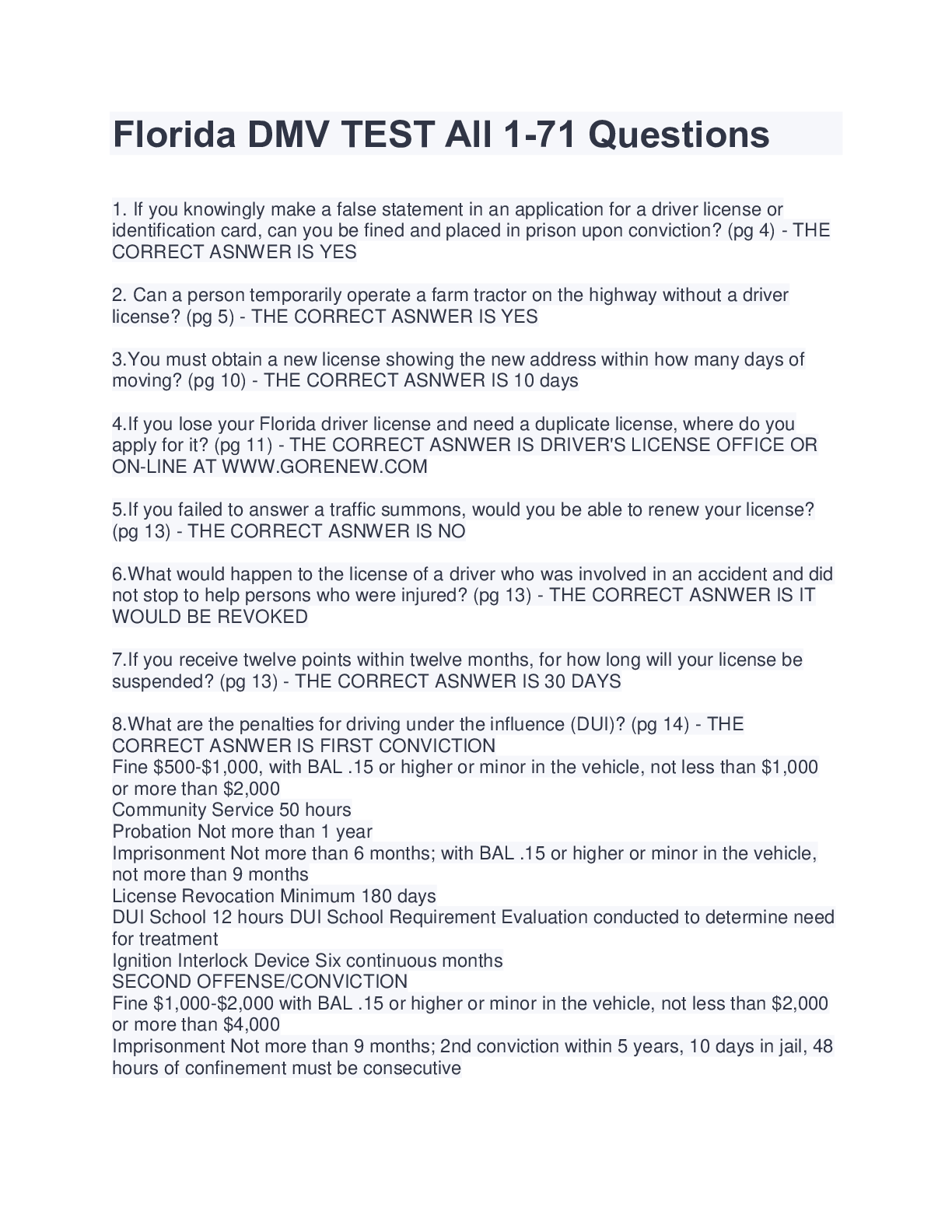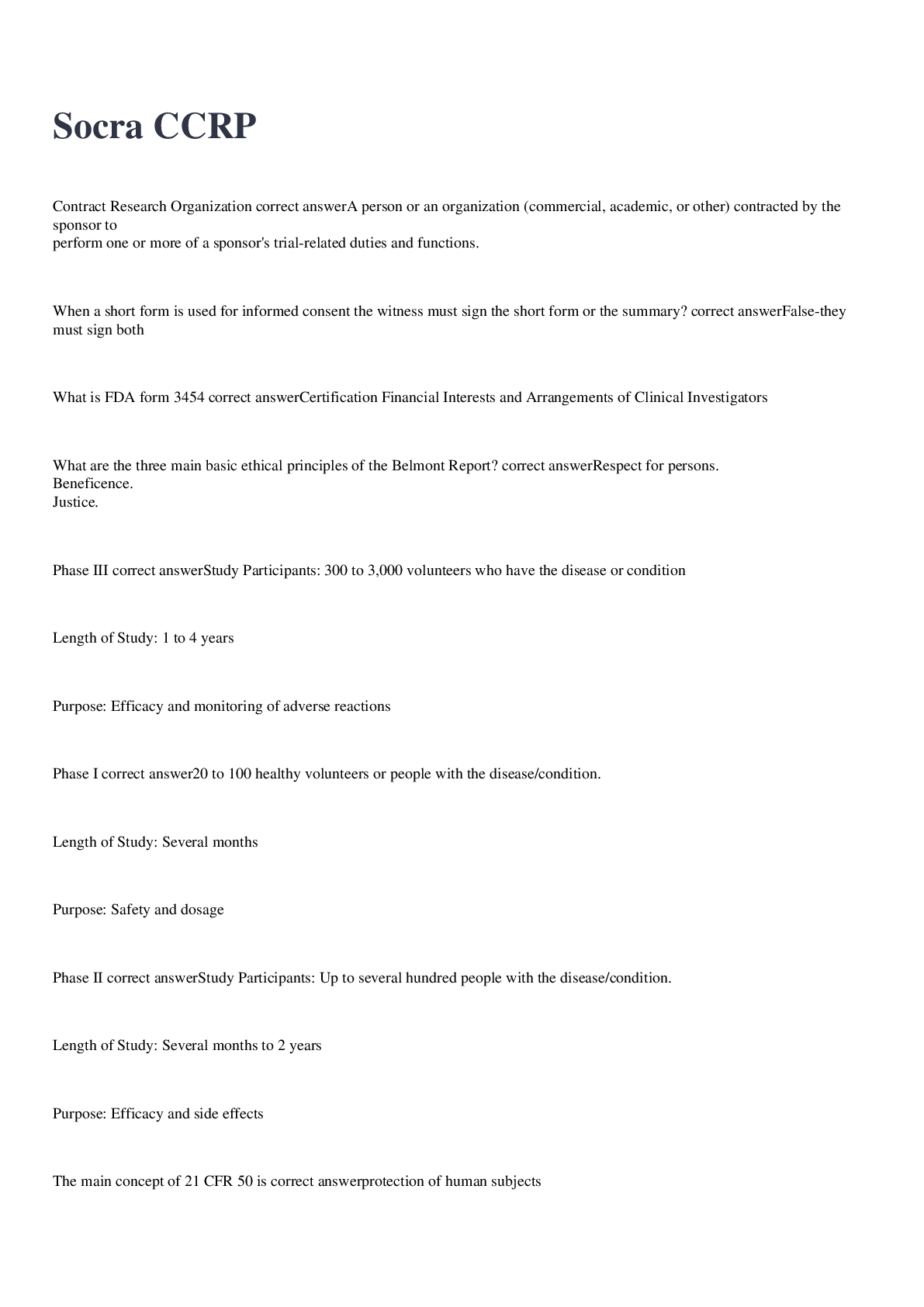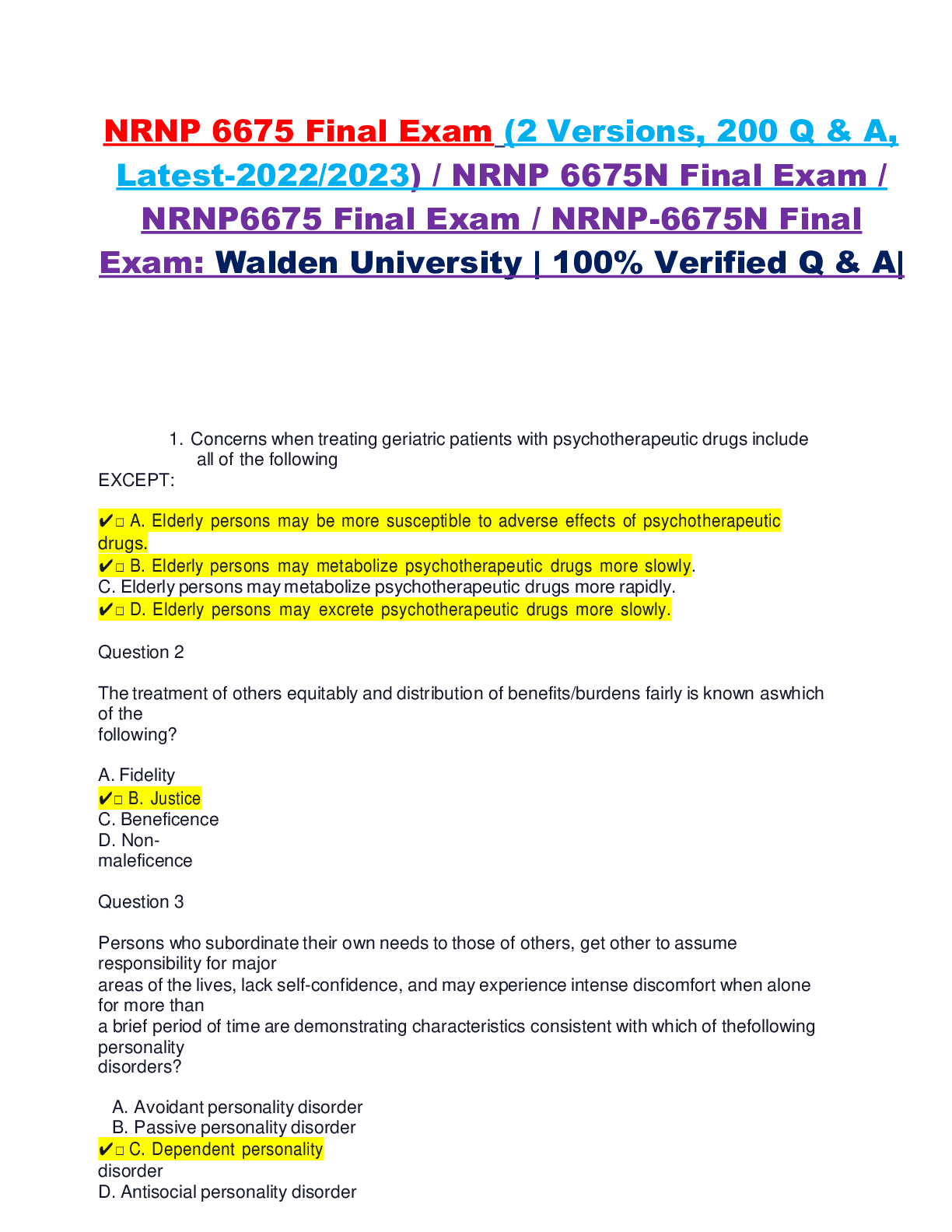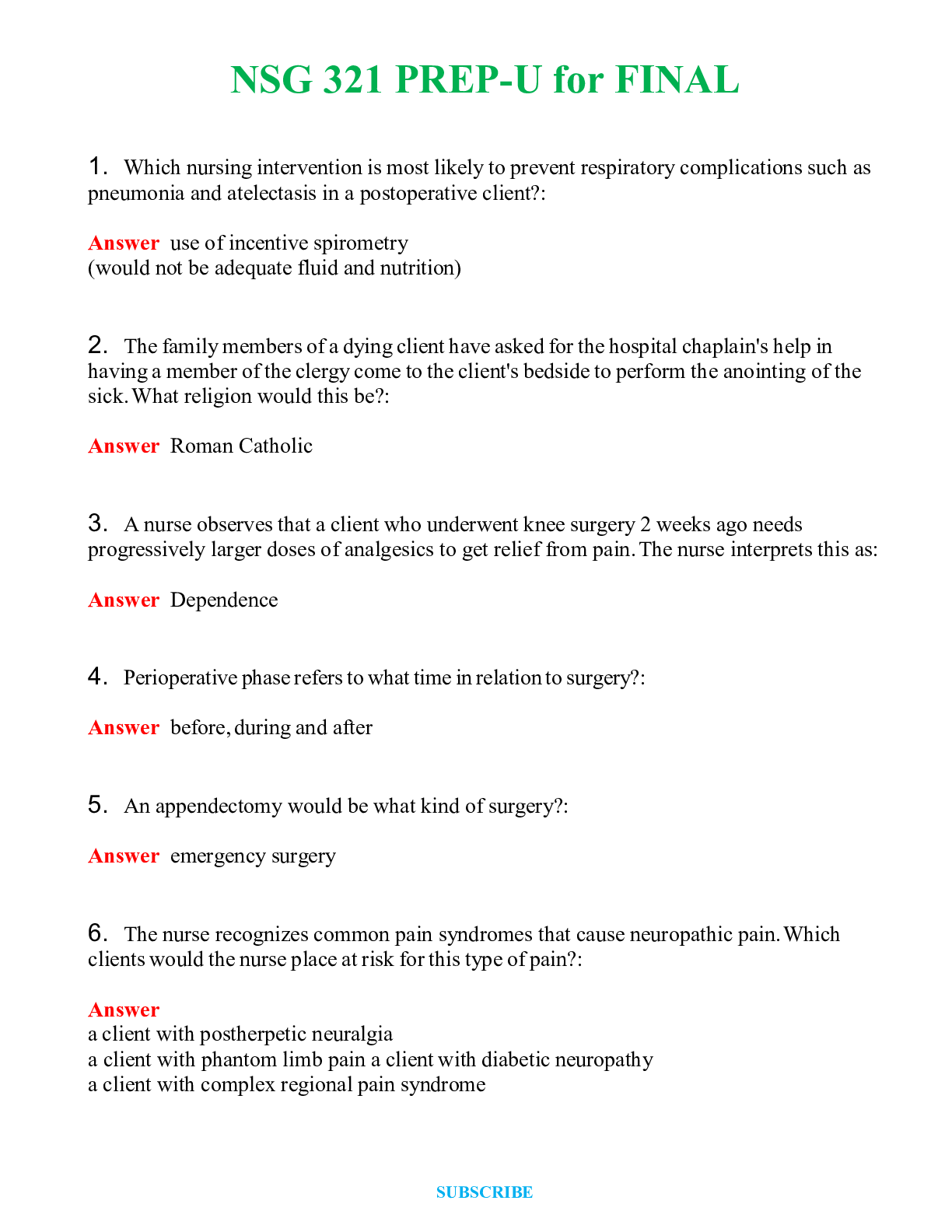Pathophysiology > EXAM > WGU patho D236 Exam With A Guaranteed 90% Pass!! (All)
WGU patho D236 Exam With A Guaranteed 90% Pass!!
Document Content and Description Below
Turner syndrome A chromosomal disorder in females in which either an X chromosome is missing, making the person XO instead of XX, or part of one X chromosome is deleted. Tay-Sachs Disease A h... uman genetic disease caused by a recessive allele for a dysfunctional enzyme leads to the accumulation of certain lipids in the brain. Seizures, blindness, and degeneration of motor and mental performance usually become manifest a few months after birth, followed by death within a few years. Down syndrome A condition of mild to severe intellectual disability and associated physical disorders caused by an extra copy of chromosome 21 Diabetes Insipidus Antidiuretic hormone is not secreted adequately, or the kidney is resistant to its effect. The serum sodium is often elevated due to excess free water losses. In diabetes insipidus, your blood glucose levels are normal, but your kidneys can't properly concentrate urine. Cardiac Valve Disease Process In heart valve disease, one or more of the valves in your heart doesn't work properly. Regurgitation (or leakage of the valve). When the valve(s) do not close completely, it causes blood to flow backward through the valve. This reduces forward blood flow and can lead to volume overload in the heart. Stenosis (or narrowing of the valve). When the valve(s) opening becomes narrowed, it limits the flow of blood out of the ventricles or atria. The heart is forced to pump blood with increased force to move blood through the narrowed or stiff (stenotic) valve(s). Cardiac Valve Complications Heart valve disease can cause many complications, including: * Heart failure. * Stroke. * Blood clots. * Heart rhythm abnormalities. * Death. Respiratory Illness from bats Viral hemorrhagic fevers are spread by contact with infected animals or insects. The viruses that cause viral hemorrhagic fevers live in a variety of animal and insect hosts. Most commonly, the hosts include mosquitoes, ticks, rodents, or bats. Some viral hemorrhagic fevers can also be spread from person to person. Anemia Different types of anemia include: Anemia due to vitamin B12 deficiency Anemia due to folate (folic acid) deficiency Anemia due to iron deficiency Anemia of chronic disease Hemolytic anemia Idiopathic aplastic anemia Megaloblastic anemia Pernicious anemia Sickle cell anemia Thalassemia Acid Base Balance - lung and kidney compensation The kidneys have two main ways to maintain acid-base balance - their cells reabsorb bicarbonate HCO3− from the urine back to the blood and they secrete hydrogen H+ ions into the urine. By adjusting the amounts reabsorbed and secreted, they balance the bloodstream's pH. Pyelonephritis Inflammation of the renal pelvis and the kidney Prostate cancer Cancer of the prostate gland usually occurs in men middle-aged and older. Artery response during blood loss. Does cell shrink or swell ? Vasoconstriction Marfan Syndrome - Autosomal dominant trait This condition is inherited in an autosomal dominant pattern , which means one copy of the altered gene in each cell is sufficient to cause the disorder. At least 25 percent of Marfan syndrome cases result from a new mutation in the FBN1 gene Spina Bifida Not having enough folic acid during pregnancy is one of the most important factors that can increase the chances of having a child with spina bifida. Bursitis Inflammation of a bursa sac. Inflammation of the fluid-filled pads (bursae) that act as cushions at the joints. Sprains and Strains A sprain occurs when you overextend or tear a ligament while severely stressing a joint.A strain occurs when tendons (bands at the end of muscles that connect muscles to bones) get stretched or pulled away from the bone. Endometriosis # Painful periods (dysmenorrhea). Pelvic pain and cramping may begin before and extend several days into a menstrual period. #Lower back and abdominal pain. #Pain with intercourse. Pain during or after sex is common with endometriosis. #Pain with bowel movements or urination. You're most likely to experience these symptoms during a menstrual period. #Excessive bleeding. You may experience occasional heavy menstrual periods or bleeding between periods (intermenstrual bleeding). #Infertility. Sometimes, endometriosis is first diagnosed in those seeking treatment for infertility. #Fatigue, diarrhea, constipation, bloating or nausea, especially during menstrual periods. Ulcerative colitis Ulcerative colitis is an autoimmune disease of the large intestine, specifically the colon and rectum. It affects the mucosal layer of the large intestine. #Aortic stenosis/regurgitation #Mitral stenosis/regurgitation Mitral valve stenosis occurs when the mitral valve in the heart narrows, restricting blood flow into the main pumping chamber. The mitral valve may also leak, causing blood to flow back through the valve each time the left ventricle contracts. This condition is called mitral valve regurgitation. Backflow of blood is caused by failure of the heart's mitral valve to close tightly. Mitral valve regurgitation is a condition in which the heart's mitral valve does not close tightly, which allows blood to flow backward in the heart. How could the provider distinguish ulcerative colitis from Crohn disease? Ulcerative colitis only affects the large intestine, while Crohn's disease can affect the entire length of the gastrointestinal tract. While diarrhea can occur in both, ulcerative colitis is more likely to present with blood in the stool. A colonoscopy will show pseudopolyps for ulcerative colitis but will show a cobblestone appearance for Crohn's disease. Pancreatitis Pancreatitis is inflammation of the pancreas that causes pancreatic insufficiency, malabsorption, and diabetes. Pancreatitis can be an acute or chronic disorder. With acute pancreatitis, there is a sudden, short-term episode of inflammation. With chronic pancreatitis, the gland undergoes repeated episodes of inflammation and gradual deterioration. Acute pancreatitis can be caused by #Gallstones #Excessive alcohol consumption #High blood triglycerides #Abdominal injury, #Certain medications and toxins. Peritonsillar abscess A complication of tonsillitis in which the infection spreads behind the tonsils. A peritonsillar abscess occurs when a collection of pus forms and infection spreads beyond the tonsils into the neck and chest. Swollen tissues can block the airway. Symptoms include fever, difficulty swallowing, and severe throat pain. Antibiotics can treat an early infection. Sometimes a collection of pus needs to be drained by a procedure called incision and drainage. Ulcers The constant acid irritation leads to ulceration of the gastrointestinal cells, also termed peptic ulcer. The constant acid irritation leads to ulceration of the gastrointestinal cells, also termed peptic ulcer. Duodenal ulcers are a type of peptic ulcer that forms in the upper small intestine. The most common symptom of a duodenal ulcer is a pain in the mid to upper stomach region, especially if this pain intensifies when the stomach is empty or if the pain wakes you up in the middle of the night. Esophageal ulcers are ulcers that develop inside of the esophagus. These ulcers can typically be treated with changes to lifestyle and diet, coupled with certain medications and other treatments. Cranial nerves *I Olfactory -Sensory- Smell *II Optic - Sensory - Vision *III Oculomotor - Motor - Extraocular movements (EOMs) and pupil response *IV Trochlear - Motor - EOMs *V Trigeminal - Mixed (motor and sensory)- Facial sensation, Masseter muscle control of chewing *VI Abducens - Motor - EOMs *VII Facial - Mixed (motor and sensory)- Facial expressions and taste over anterior two-thirds of tongue *VIII Auditory or Vestibulocochlear -Sensory- Hearing and equilibrium *IX Glossopharyngeal - Mixed (motor and sensory) -Elevation of pharynx in swallowing, taste over posterior one-third of tongue, and salivation *X Vagus - Mixed (motor and sensory) - Gag reflex and parasympathetic control of body * XI Accessory - Motor - Turn the head and shrug *XII Hypoglossal - Motor - Tongue movement Multi factorial diseases The majority of diseases are the result of multifactorial genetic influences. Diseases such as hypertension, heart disease, diabetes mellitus (DM), and most cancers are caused by a combination of genetics and environment or a combination of several defective genes working, or not working, together. In these diseases, an individual inherits one or more gene defects that predispose them to a disorder, and then environmental or behavioral triggers such as diet, exposure to toxins, or sedentary lifestyle contribute to disease development. For example, multifactorial inheritance factors are involved in the development of type 1 and type 2 DM: Fluid and Electrolytes Imbalances of the body's biological, and chemical constituents, such as electrolytes, can cause cell injury. For example, high sodium levels in the bloodstream, termed hypernatremia, cause intracellular fluid depletion (cellular dehydration) and reversible cell shrinkage. The symptoms associated with this include #Lethargy #Weakness #Irritability #Confusion Fractures Osteoporosis results in a loss of bone mass. A change in bone mineralization is characteristic of osteomalacia and rickets rather than osteoporosis. The decrease in bone density makes bones more fragile and susceptible to fracture. Ida's osteoclasts are breaking down more bone than osteoblasts are rebuilding. This results in bone loss. Turner Syndrome - characteristics Patients with suspected Turner syndrome require genetic testing and hormone level evaluation. Echocardiogram, bone density, and bone age testing are necessary. Treatment involves estrogen therapy and growth hormone administration. The patient should be treated symptomatically for all other effects of the disease. #Underdeveloped ovaries (sterile) #Short stature (~ 4'7") #Webbing of the neck #Edema #Underdeveloped breasts; wide nipples #High number of aborted fetuses Lymphedema This is the swelling or accumulation of the fluid due to a blockage in the lymphatic system caused by scar tissues from damaged lymph vessels or lymph nodes. It is often seen in patients who had their lymph nodes removed and had surgery or radiation to remove cancer. Lymphadenitis Lymphadenitis is the medical term for enlargement in one or more lymph nodes, usually due to infection. Lymph nodes are filled with white blood cells that help the body fight infections. Lymphadenopathy Enlarged lymph nodes that become palpable and tender. Bladder Cancer vs Kidney Cancer Kidney cancer, also known as renal cancer, occurs when cells in the kidney grow out of control, clump together, and form a malignant tumor. The most common risk factor for developing kidney cancer is smoking. Bladder cancer is a common type of cancer that begins in the cells of the bladder. Bladder cancer sign and symptoms, treatments The cardinal feature of bladder cancer is #Painless, intermittent, gross hematuria. #Frequency, pain, and burning on urination. #Sensation of incomplete bladder emptying. Some types of bladder cancer present similarly to a UTI with urgency, frequency, and dysuria. Usually located deep within the bladder, bladder cancer rarely presents as a palpable mass. Painless hematuria is usually the only sign of bladder cancer. Surgical treatment involves a transurethral resection of the tumor. Chemotherapy, immunotherapy, and radiation therapy are also used to eradicate the tumor or reduce tumor size. Radical cystectomy with urinary diversion may be necessary for very large invasive tumors. Mitral regurgitation In the left ventricle, papillary muscle rupture causes the mitral valve to be unable to close. With each contraction of the left ventricle, blood flows upward through the loose mitral valve into the left atrium. This causes a mitral valve regurgitation murmur, also called mitral insufficiency. As a consequence, mitral regurgitation often causes backup of blood and hydrostatic pressure into the left atrium, pulmonary veins, and pulmonary capillaries, causing pulmonary edema. Mitral stenosis In mitral stenosis, blood from the left atrium meets resistance when flowing through the narrowed mitral valve into the left ventricle. Mitral stenosis is the narrowing of the mitral valve, which controls blood flow from the heart's left atrium to the left ventricle. The left ventricle is your heart's main pumping chamber. In mitral stenosis, blood from the left atrium meets resistance when flowing through the narrowed mitral valve into the left ventricle.The main cause of mitral valve stenosis is an infection called rheumatic fever, which is related to strep infections. Blood thinners (anticoagulants) to help prevent blood clots. Beta-blockers, calcium channel blockers, or digitalis glycosides to slow your heart rate and allow your heart to fill more effectively. Anti-arrhythmics to treat atrial fibrillation or other irregular heart rhythms associated with mitral valve stenosis. Aortic regurgitation Aortic valve regurgitation — or aortic regurgitation — is a condition that occurs when your heart's aortic valve doesn't close tightly. As a result, some of the blood pumped out of your heart's main pumping chamber (left ventricle) leaks backward. Aortic stenosis Aortic stenosis is one of the most common and serious valve disease problems. Aortic stenosis is a narrowing of the aortic valve opening. Aortic stenosis restricts the blood flow from the left ventricle to the aorta and may also affect the pressure in the left atrium. Which type of valve defect leads to a diastolic murmur? Diastolic murmurs are due to a narrowing (stenosis) of the mitral or tricuspid valves, or regurgitation of the aortic or pulmonary valves. Which type of valve defect leads to a systolic murmur? Systolic regurgitant murmurs include the many variations of mitral valve regurgitation, tricuspid valve regurgitation, and ventricular septal defect. Signs and Symptoms of Hodgkins Lymphoma #Painless swelling of lymph nodes in the neck, #Armpits, or groin. #Persistent fatigue. #Fever. #Night sweats. #Losing weight without trying. #Severe itching. #Pain in lymph nodes after drinking alcohol. Electrolyte imbalance causing palpitations, diarrhea, muscle weakness Low Potassium (Hypokalemia) T4 cell - disease related to destruction Human immunodeficiency virus (HIV) infection Being able to identify degree of burn, and add other s/s to that degree burn First-degree burns affect only the outer layer of the skin. They cause pain, redness, and swelling. Second-degree burns affect both the outer and underlying layer of skin. They cause pain, redness, swelling, and blistering. Third-degree burns affect the deep layers of skin. Herbeden and Bouchard Nodes Osteoarthritis. Identify Upper vs Lower Respiratory infections Upper respiratory tract infections (URTIs). These infections affect the nose, throat, and sinuses. Lower respiratory tract infections (LRTIs). These infections occur in the airways and the lungs. Upper respiratory tract infections. # Common cold. # Epiglottitis. # Laryngitis. # Pharyngitis (sore throat). # Sinusitis (sinus infection). Lower respiratory tract infections # Bronchitis # Pneumonia # Bronchiolitis # Tuberculosis MRSA Methicillin-resistant Staphylococcus aureus (MRSA) infection is caused by a type of staph bacteria that's become resistant to many of the antibiotics used to treat ordinary staph infections. Bell's Palsy Doctors believe that the most likely cause of Bell's palsy in pregnant women is the Herpes virus. #Cold sores and genital herpes (herpes simplex) #Chickenpox and shingles (herpes zoster) #Infectious mononucleosis (Epstein-Barr) #Cytomegalovirus infections #Respiratory illnesses (adenovirus) #German measles (rubella) #Mumps (mumps virus) #Flu (influenza B) #Hand-foot-and-mouth disease (coxsackievirus) Chemical related to a chronic condition that causes endothelial cell injury. Endothelial dysfunction can be caused by several conditions, including diabetes or metabolic syndrome, hypertension, smoking, and physical inactivity Hypoventilation PH A hypoventilating (excessively shallow breathing) person does not expel enough carbon dioxide and has elevated blood carbon dioxide levels. This causes the equilibrium to shift to the right, the H3O+ concentration increases, and the pH drops. Hypoventilation may be secondary to several mechanisms, including # Central respiratory drive depression, # Neuromuscular disorders, # Chest wall abnormalities, # Obesity hypoventilation # COPD. Heart vegetations Abnormal growths (vegetations) that contain collections of bacteria may form in the heart at the site of the infection and damage the heart valves, which can cause them to leak. Endocarditis is a life-threatening inflammation of the inner lining of the heart's chambers and valves (endocardium). Coal Worker's Pneumoconiosis, the lungs are damaged. Silicosis Conditions under COPD umbrella These are three conditions that fall under the umbrella of COPD #Emphysema #Chronic bronchitis, #Refractory (non-reverse) asthma RLQ pain causes #Chrons disease #Appendicitis Peptic Ulcers Peptic ulcers are open sores that develop on the inside lining of your stomach and the upper portion of your small intestine. The most common symptom of a peptic ulcer is stomach pain. Upper abdominal pain is a common symptom. Treatment consists of antacids Cirrhosis The most common causes of cirrhosis of the liver are #Hepatitis C virus - HCV #Alcoholic liver disease #Nonalcoholic fatty liver disease -NAFLD. [Show More]
Last updated: 1 year ago
Preview 1 out of 18 pages
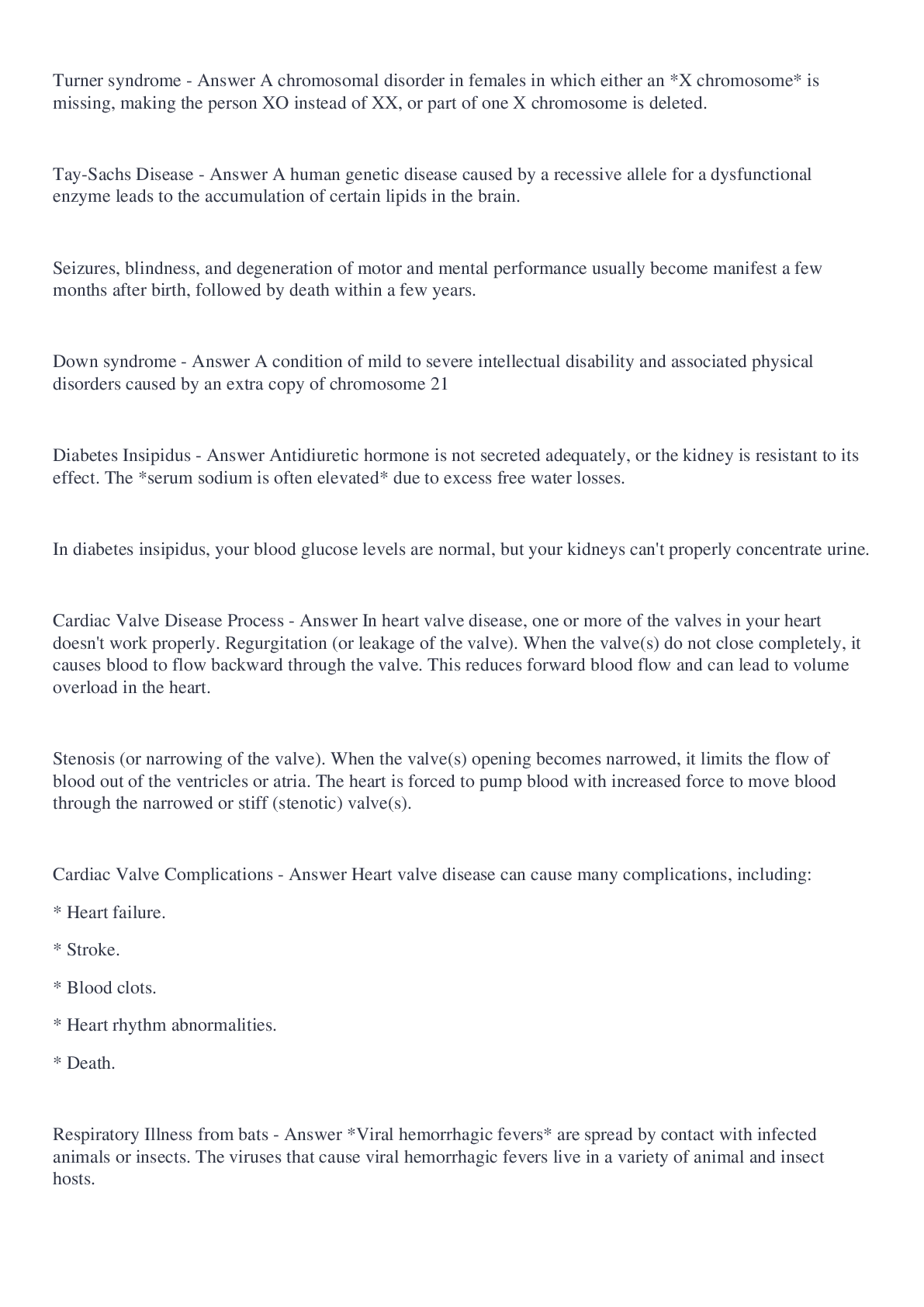
Reviews( 0 )
Document information
Connected school, study & course
About the document
Uploaded On
Nov 26, 2022
Number of pages
18
Written in
Additional information
This document has been written for:
Uploaded
Nov 26, 2022
Downloads
0
Views
47

